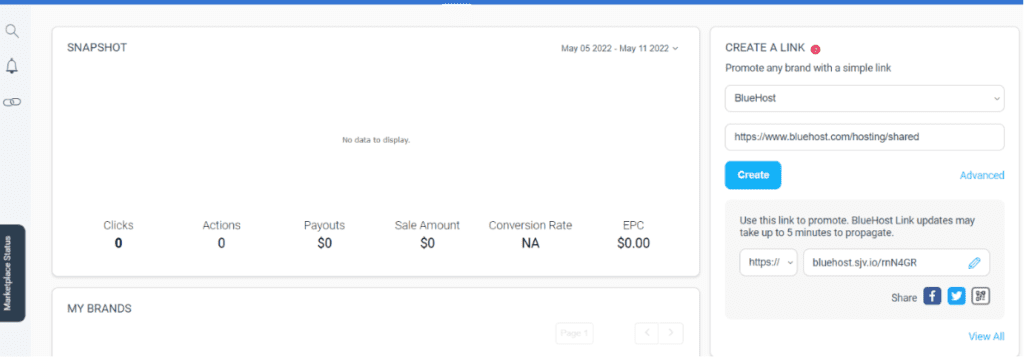Seasonal affiliate marketing helps you reach high-intent buyers when they’re most ready to act. Think back-to-school, Black Friday or year-end deals—these are perfect moments to boost blog conversions.
In this guide, we’ll share smart seasonal blog strategies to help you align with holidays, stand out in search and make the most of Bluehost promotions.
Let’s dive in!
Why seasonal affiliate marketing matters?
1. Capture high-intent holiday behavior
During holidays, people search with urgency. They’re ready to buy, act fast and spend more. This is the ideal time for seasonal affiliate content.
Events like Back-to-school, Black Friday and Cyber Monday drive traffic spikes. Your blog can meet those needs with targeted posts and timely offers.
By tapping into this behavior, your content becomes more relevant and more profitable.
Also read: Seasonal Marketing: Using Valentine’s Day and Beyond to Drive Affiliate Sales
2. Stand out in search with seasonal relevance
Search engines love fresh, time-specific content. Adding seasonal keywords improves your SEO and increases your blog’s visibility during peak times.
Use phrases like “best holiday hosting deals” or “summer blog setup tips.” These attract searchers looking for immediate solutions.
Seasonal blog strategies help you rise above evergreen competitors during high-traffic periods.
3. Align with Bluehost’s seasonal promos
Our limited-time hosting discounts give you the perfect tie-in for holiday affiliate promotions.
Create content that highlights current Bluehost offers. Use urgency-driven language to boost clicks and conversions.
Include banners, countdown timers and clear calls to action. The goal is to help readers act before the offer expires.
Also read: Using Bluehost’s Resources to Better Sell Hosting Plans
Seasonal blog strategies: Identifying key campaign windows
1. Summer sales (June – August)
Summer brings traffic from students, creators and side hustlers looking to launch projects. It’s a great time to promote Bluehost’s hosting bundles.
Blog ideas:
- “Top Summer Side Hustle Ideas That Need a Website”
- “Launch Your Blog Before Summer Ends”
Also read: How to Leverage Summer Campaigns to Boost Affiliate Sales
2. Back-to-school season (Late July – Early September)
Teachers, parents and students return online in full force. This is ideal for promoting tools that support learning, teaching or blogging.
Campaign ideas:
- “Set Up a Study Blog in One Weekend”
- “Affordable Hosting for Students and Educators”
3. Black Friday / Cyber Monday (Late November)
This is the most powerful window for seasonal affiliate marketing. Consumers actively search for big deals and make quick decisions.
Suggested content:
- “Best Black Friday Deals for Bloggers”
- “Top Bluehost Cyber Monday Offers You Shouldn’t Miss”
4. Holiday season and year-end deals (December – Early January)
From early December through New Year’s, readers want gifts, business ideas and year-end solutions. This is a prime time for blogging for seasonal promotions.
Examples:
- “Why Now Is the Best Time to Start Your Blog”
- “New Year, New Site: Holiday Hosting Deals to Grab”
Seasonal blog strategies work best when planned around proven campaign windows. These four major seasons offer strong potential for holiday affiliate promotions.
Also read: Optimizing Affiliate Content for the Holiday Shopping Season
Content types that work well in seasonal blog campaigns
1. Themed listicles and roundups
Readers love quick, skimmable lists—especially when they’re tied to a season.
Examples:
- “What are summer blog ideas for my new customers”
- “What are 5 holiday affiliate promotions you can launch today?”
These posts let you add affiliate links naturally and highlight time-sensitive tips.
Also read: Affiliate Blogging 101: Crafting High-Value Content that Sells
2. Fast-action tutorials for seasonal urgency
Create step-by-step posts that help readers take immediate action. Use headlines that promise fast results tied to a seasonal goal.
Examples:
- “How to Set Up a Holiday Blog in 24 Hours?”
- “How can you launch a back-to-school blog before the semester starts?”
These align well with holiday affiliate campaigns and Bluehost’s limited-time offers.
3. Evergreen content with a seasonal twist
Evergreen posts stay relevant all year—but adding a timely angle can boost seasonal clicks.
Examples:
- “Why Now Is a Great Time to Start Your Blog?”
- “How will you start your blog this January?”
This approach helps you repurpose successful posts while adding fresh seasonal affiliate content.
Also read: Creating Evergreen Affiliate Content that Drives Long-Term Traffic and Revenue
Campaign ideas for seasonal affiliate content planning
1. Use a content calendar to map blog ideas
A seasonal content calendar keeps your campaigns timely, consistent and aligned with affiliate promos.
Plan 4–6 weeks in advance
Seasonal content performs best when it’s published early. This gives search engines time to index your blog and readers time to act.
Mark each major season on your calendar. Brainstorm blog topics, offers and keywords ahead of time.
Sync blog timing with promo cycles
Check the Bluehost affiliate dashboard for upcoming deals. Align your publishing dates with our promotional timelines for maximum impact.
This ensures your content feels timely and ties directly to holiday affiliate promotions.
2. Use planning tools like Trello, Airtable
Trello and Airtable help you organize tasks, plan deadlines and assign responsibilities. They’re great for keeping affiliate campaigns on track.
Set up boards or spreadsheets with seasonal blog strategies, content statuses and links to promo assets.
With a clear system in place, your seasonal affiliate marketing becomes more efficient—and more effective.
Also read: Essential Tools Every Bluehost Affiliate Needs to Succeed
Optimize formats and CTAs for holiday affiliate promotions
1. Add banners, timers & urgency CTAs
Use eye-catching elements that signal urgency. Countdown timers, bold banners and phrases like “Ends Soon” push readers to act fast.
Example:
- “Grab Bluehost’s Holiday Deal — 70% Off Hosting Until Dec 25!”
These boost conversions during short promotional windows.
2. Promote Bluehost offers seasonally
Include tracking links that match each offer. Use CTA language that fits the campaign theme—like “Launch Your Blog This Summer” or “Start Fresh in the New Year.”
Bundle Bluehost promotions with campaign ideas for seasonal affiliate content. This keeps messaging focused and seasonal blog strategies actionable.
Also read: How to Write Irresistible Call-to-Actions that Convert
Promoting and distributing your seasonal content
1. Repurpose blog content into visual formats
Turn each blog post into multiple visual assets. Use Pinterest pins, Instagram carousels or YouTube Shorts to expand your reach.
For example:
- A “Top 5 Holiday Blog Ideas” post can become a short-form video series.
- A Cyber Monday guide can be turned into a carousel of quick tips.
Visual formats make your seasonal affiliate content more shareable and easier to consume.
Also read: Leveraging Video Content to Increase Affiliate Engagement
2. Use email and social scheduling tools
Plan promotional emails and social posts to match each campaign. Use tools like Buffer, Later or Mailchimp to automate delivery.
Examples:
- Schedule a “Holiday Hosting Deal Reminder” email 48 hours before the offer ends.
- Queue a countdown tweet every day during Black Friday week.
Consistent timing improves visibility and drives traffic during peak periods.
Also read: Email Marketing for Affiliates Building Trust and Driving Conversions
3. Boost visibility with influencer or partner shoutouts
Team up with fellow affiliates or niche influencers to cross-promote content. A simple shoutout or backlink exchange can expand your reach fast.
This tactic works especially well during big holiday affiliate campaigns when everyone’s focused on promotions.
Tracking seasonal campaign success and iterating
1. Use the Bluehost Affiliate Dashboard

The Bluehost Affiliate Dashboard is your command center for seasonal affiliate marketing. It helps you track, manage and refine your campaigns in real time.
Here’s what you can do with it:
- Track clicks, signups and conversions for each affiliate link
- Generate custom tracking links for blog posts, email campaigns or social shares
- View real-time performance metrics to see which seasonal affiliate content is driving results
- Access ready-made assets, like banners and promo graphics for each holiday or campaign
- Monitor commission earnings and payout status for complete transparency
- Compare performance across different campaigns to identify high-converting content
Using the dashboard regularly helps you stay focused and improve each holiday affiliate campaign with data-driven insights.
2. Compare year-over-year seasonal ROI
Did your holiday affiliate campaigns perform better than last year? Compare past and present results to see what improved and what didn’t.
Look for patterns:
- Are Black Friday posts your strongest performers?
- Does back-to-school content need better timing or messaging?
This comparison helps refine your seasonal blog strategies for next time.
3. Tweak copy, visuals & timing for better results
Small changes can make a big difference. A/B test blog headlines, CTA buttons or posting times to see what resonates more.
Example:
- Try “Launch Your Blog Before Summer Ends” vs. “Start Your Summer Side Hustle Today.”
Keep what works, improve what doesn’t—and apply those learnings to the next campaign cycle.
Also read: Affiliate Goals for 2025: How to Plan and Achieve Success this Year
Final thoughts
Seasonal affiliate marketing isn’t just about timing—it’s about strategy, planning and knowing your audience. When you pair strong seasonal blog strategies with Bluehost’s promotions, you create real opportunities for growth.
From summer sales to year-end holidays, each campaign window is a chance to connect with high-intent readers. Use tools like the Bluehost Affiliate Dashboard, content calendars and design elements to stay ahead.
Plan early, promote smart and always track what works. Your next big affiliate win could be just one seasonal campaign away.
FAQs
Start by identifying key holidays or events your audience cares about. Then, create blog posts 4–6 weeks in advance. Use seasonal keywords, themed headlines and timely CTAs to match reader intent.
Listicles, tutorials and evergreen content with seasonal angles work well. Focus on solving immediate needs with fast, actionable advice tied to a current event or promotion.
Use tools like Trello or Airtable to map out blog ideas. Stick to 2–3 campaigns per season and align your posts with Bluehost’s affiliate promotions for better results.



Write A Comment